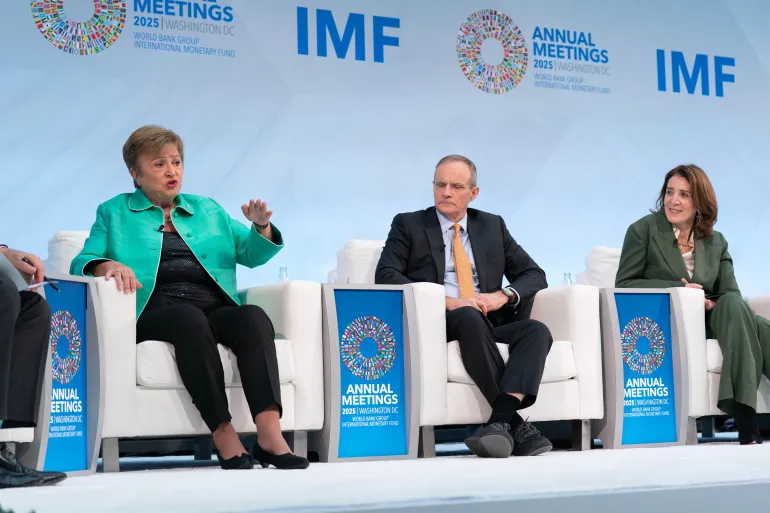Which Countries Owe the IMF the Most Money in 2025?
ECONOMICS, 27 Oct 2025
Hanna Duggal | Al Jazeera - TRANSCEND Media Service

IMF Managing Director Kristalina Georgieva, Professor of Entrepreneurship at the MIT Sloan School of Management Simon Johnson and President and Chief Investment Officer of Alphabet and Google Ruth Porat speak at the World Bank/IMF Annual Meetings in Washington, DC, on 15 Oct 2025.
[Jose Luis Magana/AP Photo]
From Argentina to Egypt, at least 86 countries collectively owe the International Monetary Fund more than $162bn.
16 Oct 2025 – Central bankers and financial delegates have gathered in Washington, DC this week for the annual International Monetary Fund (IMF) and World Bank meetings, which conclude on Saturday.
Discussions this week have focused on global economic headwinds, as the IMF warns of signs of distress following US trade tariffs and protectionism.
The IMF is widely seen as a “lender of last resort”, only stepping in when countries face severe financial crises and cannot access usual borrowing channels. Its loans, however, often come with strict conditions which can result in austerity measures and deepen social and economic hardships, making the loans a double-edged sword.
What is the IMF and how does it fund itself?
Founded in 1944 during World War II at the Bretton Woods Conference in New Hampshire, US, the IMF was established to help stabilise the post-war global economy. Now based in Washington, DC, it has since grown from 44 founding members to 191 today and works closely with the United Nations and other international organisations to support global financial stability.
It does this by providing policy advice, short-term financial assistance and capacity development to countries and institutions.
Any country can join the IMF if approved by existing members and by paying a quota based on the size of its economy, with wealthier countries contributing more. This quota is used to set how much the country contributes, how much it can borrow and how much voting power it has.

How big is the IMF’s fund?
Overall, the IMF has a total lending capacity of about $1 trillion.
When the IMF lends money, it draws on the pooled resources of its member countries. Wealthier and more stable economies often act as creditors, supplying the funds the IMF uses to provide loans. In return, these creditor countries earn interest on their contributions.
In 2024, about 50 creditor nations received approximately $5bn collectively in interest.
Which countries owe the most money to the IMF?
The amount of money owed to the IMF is typically expressed as Special Drawing Rights (SDRs), the IMF’s own unit of account based on a basket of five currencies – the US dollar, euro, pound sterling, the Chinese renminbi and the Japanese yen.
While SDRs are not a currency, countries can exchange them for the currencies mentioned above. As of October 15, one SDR was equivalent to $1.36.
The IMF currently has the highest-ever total credit outstanding. The chart below shows how much money has been owed to the IMF over the past 40 years.
How much money do countries owe to the IMF?
Countries borrowing more from the IMF relative to their GDP indicate a heavier reliance on the organisation.
TO CONTINUE READING Go to Original – aljazeera.com
Tags: Debt, IMF
DISCLAIMER: The statements, views and opinions expressed in pieces republished here are solely those of the authors and do not necessarily represent those of TMS. In accordance with title 17 U.S.C. section 107, this material is distributed without profit to those who have expressed a prior interest in receiving the included information for research and educational purposes. TMS has no affiliation whatsoever with the originator of this article nor is TMS endorsed or sponsored by the originator. “GO TO ORIGINAL” links are provided as a convenience to our readers and allow for verification of authenticity. However, as originating pages are often updated by their originating host sites, the versions posted may not match the versions our readers view when clicking the “GO TO ORIGINAL” links. This site contains copyrighted material the use of which has not always been specifically authorized by the copyright owner. We are making such material available in our efforts to advance understanding of environmental, political, human rights, economic, democracy, scientific, and social justice issues, etc. We believe this constitutes a ‘fair use’ of any such copyrighted material as provided for in section 107 of the US Copyright Law. In accordance with Title 17 U.S.C. Section 107, the material on this site is distributed without profit to those who have expressed a prior interest in receiving the included information for research and educational purposes. For more information go to: http://www.law.cornell.edu/uscode/17/107.shtml. If you wish to use copyrighted material from this site for purposes of your own that go beyond ‘fair use’, you must obtain permission from the copyright owner.
Join the discussion!
We welcome debate and dissent, but personal — ad hominem — attacks (on authors, other users or any individual), abuse and defamatory language will not be tolerated. Nor will we tolerate attempts to deliberately disrupt discussions. We aim to maintain an inviting space to focus on intelligent interactions and debates.